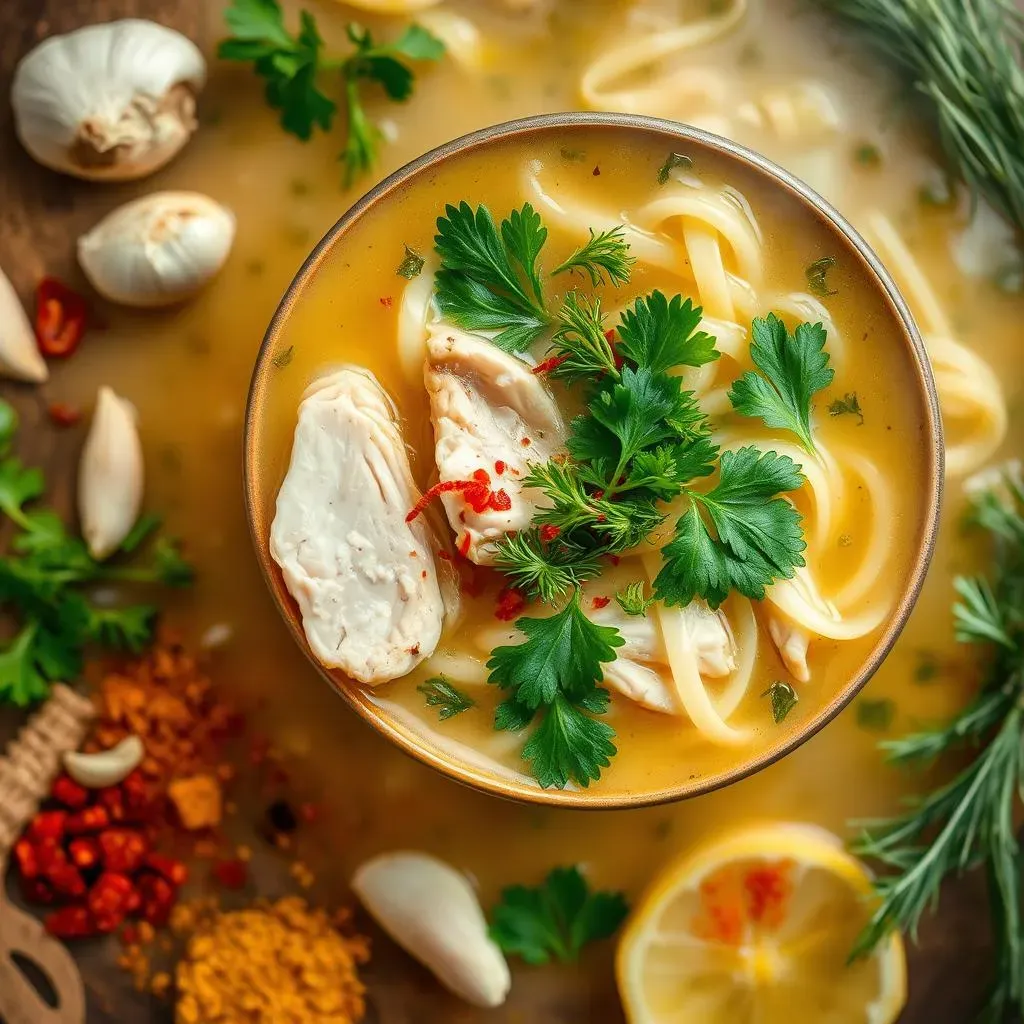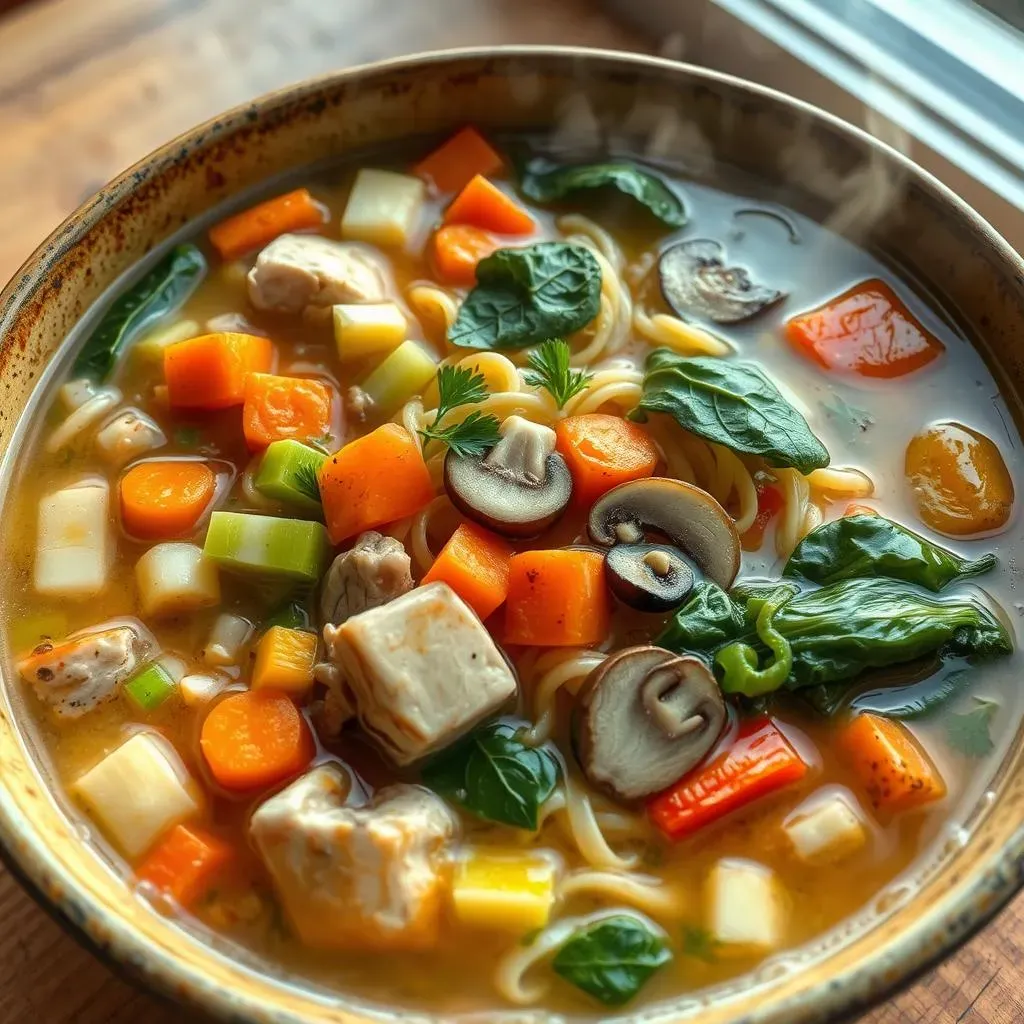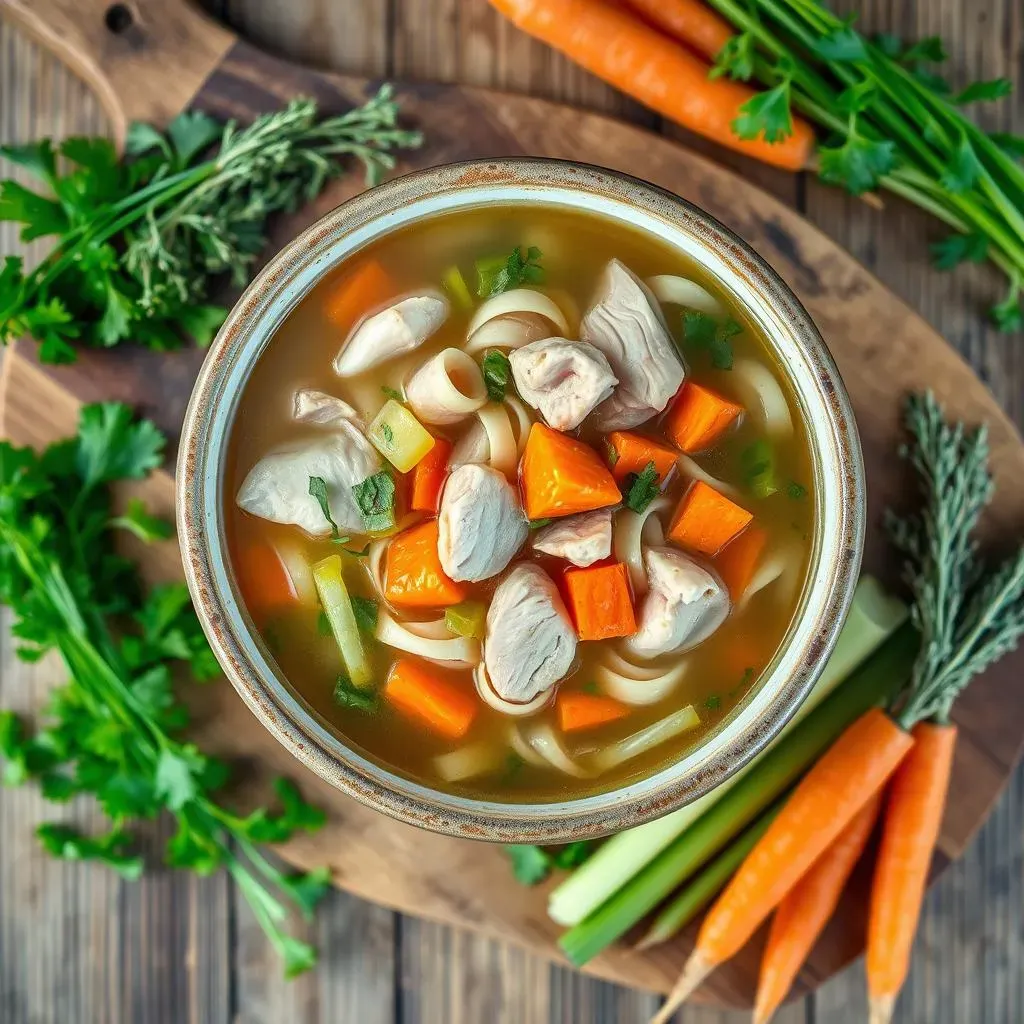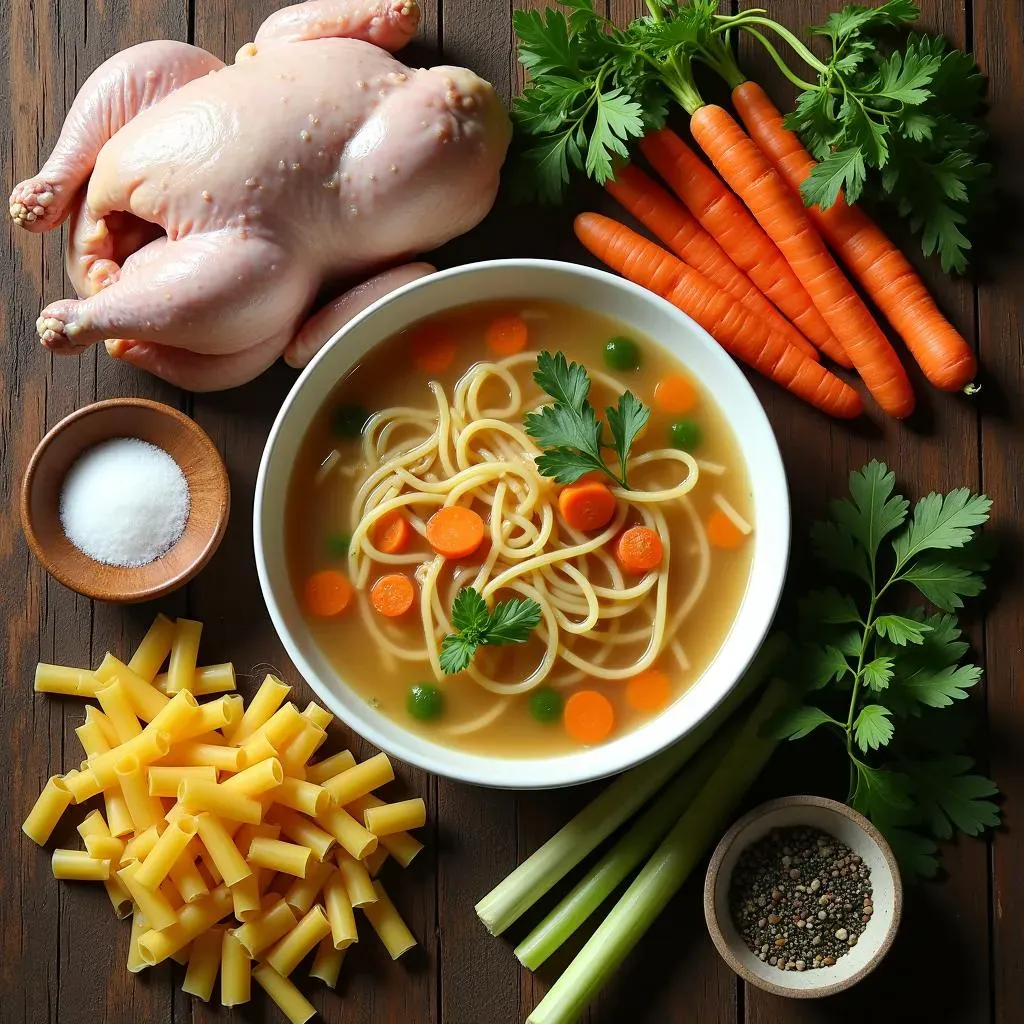Table of Contents
Craving a warm, comforting bowl of chicken noodle soup? The secret to a truly exceptional soup lies in the quality and combination of its chicken noodle soup recipe ingredients. Forget bland, store-bought versions – we're diving deep into what makes this classic dish sing. This isn't just about throwing a few things into a pot; it's about understanding how each ingredient contributes to the overall flavor and texture. From the perfect broth to the ideal noodle, we'll explore the essential components that elevate chicken noodle soup from simple to sublime. We'll also cover flavorful additions, like herbs and spices, that can take your soup to the next level. Get ready to discover the best vegetables to include and preparation tips that ensure a delicious, satisfying bowl every time. So, grab your apron, and let's explore the world of chicken noodle soup recipe ingredients!
Essential Chicken Noodle Soup Recipe Ingredients

Essential Chicken Noodle Soup Recipe Ingredients
The Foundation: Chicken, Broth, and Noodles
Let's face it, chicken noodle soup wouldn't be chicken noodle soup without, well, chicken! But it's not just any chicken; the type you choose significantly impacts the flavor. Rotisserie chicken is a fantastic shortcut, offering both convenience and depth of flavor (plus, you can use the carcass for stock!). Raw chicken thighs are another great option, yielding tender, juicy meat that infuses the broth with richness. And don't forget the broth itself – it's the backbone of the entire soup. Homemade chicken stock is the gold standard, but a good quality store-bought broth will do in a pinch. Just be sure to opt for low-sodium to control the saltiness.
And what about the noodles? Egg noodles are the classic choice, providing that comforting, slightly chewy texture we all know and love. But feel free to experiment! Wide noodles, ditalini, or even gluten-free options can all work beautifully. The key is to cook them separately or add them towards the end of the cooking process to prevent them from becoming mushy. Nobody wants a bowl of gummy noodle soup!
Veggies: The Unsung Heroes
While chicken, broth, and noodles take center stage, the vegetables are the unsung heroes, adding vital nutrients, flavor, and texture. The holy trinity of onion, carrots, and celery forms the aromatic base for most chicken noodle soup recipes. Sautéing these vegetables in butter or olive oil before adding the broth unlocks their sweetness and creates a deeper, more complex flavor profile. Don't rush this step – let them soften and become fragrant.
Beyond the basics, consider adding other vegetables to customize your soup. Diced potatoes offer heartiness, while zucchini or spinach add a touch of freshness and color. Mushrooms contribute an earthy umami flavor. Just remember to adjust the cooking time accordingly, adding vegetables that require longer cooking times earlier in the process. And don't be afraid to get creative – experiment with different combinations to find your perfect blend.
Vegetable | Flavor Contribution | Best Time to Add |
|---|---|---|
Onion | Aromatic base | Beginning |
Carrots | Sweetness, color | Beginning |
Celery | Savory, slightly peppery | Beginning |
Potatoes | Heartiness | With carrots and celery |
Spinach | Freshness, nutrients | Last few minutes |
Adding Flavor: Herbs, Spices, and Other Chicken Noodle Soup Recipe Ingredients

Adding Flavor: Herbs, Spices, and Other Chicken Noodle Soup Recipe Ingredients
The Power of Herbs
so you've got your base ingredients down. Now it's time to really make that chicken noodle soup sing! And that's where herbs come in. Fresh herbs, in particular, can add a burst of flavor that dried herbs just can't match. Parsley is a classic choice, offering a clean, slightly peppery note. Dill brings a bright, lemony flavor that complements the chicken beautifully. And thyme adds a subtle earthiness that ties everything together. But don't be afraid to experiment! Rosemary, oregano, or even a touch of sage can all add unique dimensions to your soup.
When using fresh herbs, it's best to add them towards the end of the cooking process to preserve their delicate flavors. Simply chop them finely and stir them in just before serving. For dried herbs, add them earlier on, along with the vegetables, to allow their flavors to fully infuse the broth. Remember, a little goes a long way, so start with a small amount and adjust to taste. You can always add more, but you can't take it away!
Spice it Up: Beyond Salt and Pepper
While salt and pepper are essential, there's a whole world of spices out there just waiting to elevate your chicken noodle soup. A bay leaf, simmered in the broth, adds a subtle depth of flavor that's hard to pinpoint but definitely noticeable. Garlic, minced or roasted, brings a pungent aroma and savory note. And a pinch of red pepper flakes can add a touch of heat to warm you from the inside out. But don't stop there! Turmeric, with its earthy flavor and vibrant color, is a great addition, as is ginger, which adds a zesty warmth.
When using spices, it's important to consider their intensity. Some spices, like cayenne pepper, can quickly overpower the soup, so use them sparingly. Others, like turmeric, are more subtle and can be used more generously. A good rule of thumb is to start with a small amount and taste as you go, adding more until you reach your desired flavor profile. And remember, the best chicken noodle soup is the one that tastes best to you!
Spice | Flavor Contribution | Best Time to Add |
|---|---|---|
Bay Leaf | Subtle depth | Simmer with broth |
Garlic | Pungent, savory | Sauté with vegetables |
Red Pepper Flakes | Heat | Add to taste |
Turmeric | Earthy, warm | Sauté with vegetables |
Ginger | Zesty, warm | Sauté with vegetables |
Noodles and Broth: Key Chicken Noodle Soup Recipe Ingredients

Noodles and Broth: Key Chicken Noodle Soup Recipe Ingredients
Noodle Nirvana: Choosing the Right Type
Alright, let's talk noodles! This is where personal preference really shines. While egg noodles are the undisputed champion of chicken noodle soup, they're not the only contender. Their slightly chewy texture and rich flavor complement the broth and chicken perfectly. But if you're looking to mix things up, there are tons of other options to explore. For a heartier soup, try wide egg noodles or even something like rotini. For a more delicate soup, consider ditalini or acini di pepe. And if you're gluten-free, don't despair! There are plenty of gluten-free noodle options available, from rice noodles to quinoa pasta. Just be sure to adjust the cooking time accordingly.
The key to perfect noodles is to avoid overcooking them. Nobody wants a bowl of mush! Cook them separately and add them to the soup just before serving, or add them directly to the soup in the last few minutes of cooking. This will ensure that they're perfectly al dente and retain their shape. Also, consider the size and shape of your noodles when determining how much to use. You want enough noodles to add substance to the soup, but not so many that they overwhelm the other ingredients.
Broth Basics: Homemade vs. Store-Bought
Now, let's move on to the broth – the liquid gold that binds everything together! Homemade chicken stock is, without a doubt, the holy grail. It's rich, flavorful, and packed with nutrients. Plus, it's a great way to use up leftover chicken bones and vegetable scraps. But let's be real, not everyone has the time or inclination to make their own stock. And that's perfectly okay! There are plenty of high-quality store-bought broths available that can serve as a great substitute. Just be sure to choose a low-sodium option so you can control the saltiness of your soup.
When choosing a store-bought broth, look for one that's clear and has a rich, chicken-y aroma. Avoid broths that are cloudy or have a metallic smell. You can also enhance the flavor of store-bought broth by adding some aromatics, such as onion, garlic, and herbs, while it simmers. And don't be afraid to experiment with different types of broth! Vegetable broth, for example, can add a subtle sweetness and complexity to your soup. Or, for a richer flavor, try using bone broth.
The Perfect Ratio: Balancing Noodles and Broth
So, you've got your noodles and your broth. But how do you know how much of each to use? The perfect ratio of noodles to broth is a matter of personal preference, but a good starting point is about 1 cup of noodles per 4 cups of broth. This will give you a soup that's hearty but not too thick. If you prefer a soup that's more broth-heavy, reduce the amount of noodles. Or, if you prefer a soup that's more noodle-heavy, increase the amount of noodles.
Remember that noodles will absorb liquid as they cook, so it's always better to err on the side of too much broth than too little. You can always add more noodles later if needed. And don't forget to season your broth generously with salt, pepper, and other spices. The broth is the foundation of the entire soup, so it needs to be flavorful enough to stand on its own. With the right noodles and broth, you're well on your way to creating a truly unforgettable bowl of chicken noodle soup!
Vegetables to Include in Your Chicken Noodle Soup Recipe

Vegetables to Include in Your Chicken Noodle Soup Recipe
The Aromatic Base: Onions, Carrots, and Celery
let's talk veggies! You can't have a proper chicken noodle soup without the classic trio: onions, carrots, and celery. These aren't just filler; they form the aromatic foundation upon which the entire flavor profile is built. Think of them as the opening act, setting the stage for the stars of the show (chicken and noodles, of course!). When sautéed in butter or olive oil at the beginning, they release their natural sweetness and create a depth of flavor that's simply irresistible. But don't just toss them in and hope for the best – take your time and let them soften and become fragrant. This is where the magic happens!
As for the specifics, yellow onions are a great all-around choice, providing a balanced flavor that's not too sharp or too sweet. Carrots add a touch of sweetness and vibrant color, while celery contributes a subtle savory note with a hint of pepper. Dice them all into roughly the same size so they cook evenly. And remember, fresh is always best! But if you're short on time, frozen diced vegetables can work in a pinch. Just be sure to thaw them before adding them to the pot.
Beyond the Basics: Expanding Your Vegetable Horizons
So, you've got your onions, carrots, and celery. But why stop there? Chicken noodle soup is a blank canvas, just waiting for you to unleash your culinary creativity! Adding other vegetables can boost the nutritional value, add interesting textures, and create unique flavor combinations. Diced potatoes, for example, add heartiness and substance, turning your soup into a more filling meal. Zucchini or spinach bring a touch of freshness and vibrant color, while mushrooms contribute an earthy, umami flavor that complements the chicken beautifully.
When experimenting with other vegetables, consider their cooking times. Potatoes and other root vegetables should be added along with the carrots and celery, as they require longer to cook. Leafy greens like spinach should be added at the very end, just before serving, as they wilt quickly. And don't be afraid to think outside the box! Bell peppers, peas, green beans, or even corn can all be delicious additions. Just remember to taste as you go and adjust the seasonings accordingly.
Vegetable | Flavor Contribution | Best Time to Add |
|---|---|---|
Potatoes | Heartiness, starch | With carrots and celery |
Zucchini | Freshness, mild flavor | Last 15 minutes |
Spinach | Freshness, nutrients | Last few minutes |
Mushrooms | Earthy, umami | Sauté with aromatics |
Bell Peppers | Sweetness, slight spice | Sauté with aromatics |
Considerations for Texture and Flavor Balance
When adding vegetables to your chicken noodle soup, it's important to consider not only their flavor but also their texture. You want a variety of textures to keep things interesting, but you also want to avoid anything that's too mushy or too crunchy. Root vegetables like carrots and potatoes should be cooked until they're tender but still hold their shape. Leafy greens should be wilted but not slimy. And vegetables like zucchini and mushrooms should be cooked until they're tender-crisp.
It's also important to balance the flavors of the different vegetables. If you're using a lot of sweet vegetables like carrots and corn, you might want to add something with a bit of bitterness or acidity, like spinach or bell peppers, to balance things out. And if you're using a lot of earthy vegetables like mushrooms and potatoes, you might want to add something with a bit of brightness, like zucchini or peas, to liven things up. Ultimately, the best way to find the perfect balance is to experiment and taste as you go. Don't be afraid to try new combinations and trust your own palate.
Tips for the Best Chicken Noodle Soup Recipe: Ingredient Selection and Preparation

Tips for the Best Chicken Noodle Soup Recipe: Ingredient Selection and Preparation
Selecting the Freshest Ingredients
let's get down to brass tacks. The absolute best chicken noodle soup starts with the freshest possible ingredients. Seriously, it makes a world of difference. When you're picking out your chicken, look for plump, juicy pieces with good color. If you're going the rotisserie route, grab one that's still warm and smells amazing. For vegetables, choose ones that are firm, vibrant, and free from blemishes. And when it comes to herbs, fresh is always best. Look for bright green leaves that aren't wilted or brown. Trust me, your taste buds will thank you.
Don't underestimate the power of quality ingredients! Organic chicken and vegetables can add an extra layer of flavor and nutrients. And if you're feeling ambitious, consider growing your own herbs. Nothing beats the taste of freshly picked parsley or thyme. Even a small pot on your windowsill can make a big difference. Remember, you're not just making soup; you're creating an experience. And that experience starts with the ingredients you choose.
Mastering the Art of Preparation
So, you've got your ingredients. Now it's time to get cooking! But before you start throwing everything into the pot, take a moment to consider your preparation techniques. Dicing your vegetables into uniform sizes ensures that they cook evenly. Sautéing them in butter or olive oil before adding the broth unlocks their flavors and creates a richer, more complex base. And don't forget to season as you go! A pinch of salt and pepper at each stage of the cooking process will help to bring out the natural flavors of the ingredients.
Another key tip is to avoid overcooking your noodles. Nobody wants a bowl of mush! Cook them separately and add them to the soup just before serving, or add them directly to the soup in the last few minutes of cooking. This will ensure that they're perfectly al dente and retain their shape. And finally, don't be afraid to adjust the seasonings to your liking. Taste as you go and add more salt, pepper, herbs, or spices until you reach your desired flavor profile. Remember, cooking is an art, not a science. So have fun and experiment until you find your perfect chicken noodle soup recipe!
Preparation Tip | Why It Matters |
|---|---|
Dice vegetables uniformly | Ensures even cooking |
Sauté vegetables before adding broth | Unlocks flavors, creates richer base |
Season as you go | Brings out natural flavors |
Avoid overcooking noodles | Maintains texture, prevents mushiness |
Adjust seasonings to taste | Creates personalized flavor profile |
Conclusion: Mastering Chicken Noodle Soup Recipe Ingredients
From selecting the right chicken to perfecting your broth and noodle choices, understanding the importance of each chicken noodle soup recipe ingredient is key to creating a truly memorable bowl. Experiment with different herbs, spices, and vegetables to personalize your soup and make it your own. With these tips and insights, you're well-equipped to craft a chicken noodle soup that not only comforts but also delights. So, go ahead, embrace the art of soup-making, and enjoy the warmth and flavor of your homemade creation!
